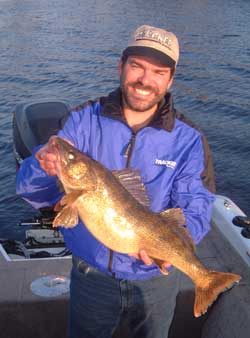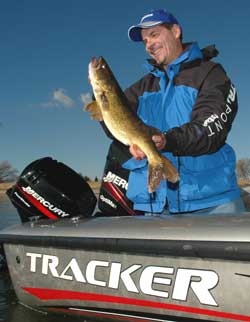 I once heard walleye fishing described as a "game of edges". That may not have been the way I’d describe it, but after some reflection I could understand where one would come up with such an analogy. It seems particularly fitting when referring to the part of the fishing season we’re fast approaching; that period marked by the seasonal transition of Spring to Summer.
I once heard walleye fishing described as a "game of edges". That may not have been the way I’d describe it, but after some reflection I could understand where one would come up with such an analogy. It seems particularly fitting when referring to the part of the fishing season we’re fast approaching; that period marked by the seasonal transition of Spring to Summer.
Most early spring walleye fishing can be pretty predictable. All it really takes is to be in the vicinity of the walleyes’ spawning grounds and you’re likely to contact fish. However, as the spawning season progresses and walleyes begin the transition through post spawn, it’s not at all uncommon to hear a lot of anglers asking "Where have the walleyes gone?" The walleyes have finished their spawning ritual, but haven’t yet set-up on classic summer habitat. It’s a pattern (or lack of one) that many walleye anglers struggle with every season. You could call it one of those "in-between" times, or a transition period where walleyes are moving from one season to the next. You can catch fish during this period, you can even have great catches, but the walleyes tend to be "here today – gone tomorrow", making consistent success iffy at best. This is where the "game of edges" comes into play, because the key to catching these fish is to concentrate in the general area surrounding structural edges.
Unless you’re dealing with gin-clear water, walleyes won’t be found on deep structure, nor do they tend to be really shallow right now. Look for these transitional walleyes somewhere in the middle, in that eight to twenty foot range. They’ll usually be relating to the primary break closest to their spawning areas, the primary break being defined as the first major drop off from shore. For instance, if the shore tapers off to say ten feet, then drops into fifteen, that’s the primary break for that area. Even though locating this break sounds simple enough, it’s important to pin point where on the "drop off" they are located. They may be on the bottom edge, the top edge, someplace in between, or on the flat adjacent to the top edge.
If the weather has been stable, and conditions prime for the fish to be active and feeding, look for them to be near the top edge of the break. That’s not to say they’ll be right on the edge, but they won’t be far from it. They could be cruising the adjoining flat chasing schools of minnows … but they won’t be far from the edge. A flat with sporadic or newly emerging weed growth, makes the situation all the better. In fact, weeds on the flat create a different set of edges that attract the fish this time of year. These edges offer travel routes as well as ambush points for feeding fish. On many lakes, you’ll begin noticing better catch rates early and late in the day … probably because the walleyes are sitting tight to the primary break during mid-day, and moving on to the flat to feed during low-light periods.
 So what’s the best way to catch these "walleyes on the edge"? That’s a tough one … the problem being that this period between spawn and summer peak can be a time when virtually every tactic in your arsenal will catch fish under the right circumstances. That may make it sound easy, but the key here is "under the right circumstances". Picking the right presentation for the given situation when you have so many options can play havoc on the minds of many anglers.
So what’s the best way to catch these "walleyes on the edge"? That’s a tough one … the problem being that this period between spawn and summer peak can be a time when virtually every tactic in your arsenal will catch fish under the right circumstances. That may make it sound easy, but the key here is "under the right circumstances". Picking the right presentation for the given situation when you have so many options can play havoc on the minds of many anglers.
Let’s look at a couple scenarios. Its late spring and you’ve got a beautiful, calm and sunny day. You’ve found a primary drop off that goes from six feet down to ten off a large flat with scattered weeds along the top edge. The break runs pretty well defined for about a hundred yards, so you start off working along it with bottom bouncers and spinners. Things aren’t looking very promising for the first fifty yards, then "bang" … you catch a nice sixteen incher. Thinking you’re on to something you continue on. Another thirty yards you go untouched and then "bang" … another decent fish. You could go all day like that but you decide to turn around and go back through the area. This time you pay close attention to your electronics, and notice that the spots those fish came from were two small hard-bottom points that jut out into deeper water. These irregularities in the break are classic fish holding structures. While you could keep trolling back and forth with the spinners, and probably pick up a few more fish, you’ll risk spooking those fish off and be forced to start looking else where. A better plan of attack would be to put away the bouncer rod, pick up a jig stick and try pitching small jigs to those isolated points on the break. You’ll also want to make a few pitches to the weeds along the top of the break, as these can also hold neutrally active fish under these conditions.
For the next scenario, the primary break runs across the entire mouth of a large bay … several hundred yards wide, dropping off from fifteen to twenty feet off the edge. The flat is covered with scattered rock piles, clam beds, and sparse newly emergent weed growth. There’s a fair "walleye chop", and it’s an overcast day. With the low-light conditions and the deeper flat, it’s a good bet that the walleyes will be up and roaming. This would be a great time to pull out the trolling rods and concentrate your efforts pulling crankbaits over the flat just inside the edge of the break. While there’s little need to spread lines out too far (remember, the walleyes are likely to be close to the edge of the drop), we’ve found that it never hurts in a situation like this to run one line out on an Off Shore Tackle OR-12 Side Planer so that it’s running well up on the flat. It’s amazing how many times that has accounted for a bonus fish or two in the course of a day. Keep your crankbait selection simple … you’re still dealing with fairly cool water temps, so stick with moderate action crankbaits that will dive easily to the depths you’re targeting.
Of course that’s just two scenarios out of dozens that you may encounter during this transition period. And this "edge" deal doesn’t come in to play on every body of walleye water … the Great Lakes for instance have transitional patterns of their own … but that’s a subject for another article. For most of us, walleye fishing during this period between spring and summer will be all about edges. After all, it’s been a long winter, and waiting to get out and catch our favorite fish has us all feeling a bit on the edge anyway.










